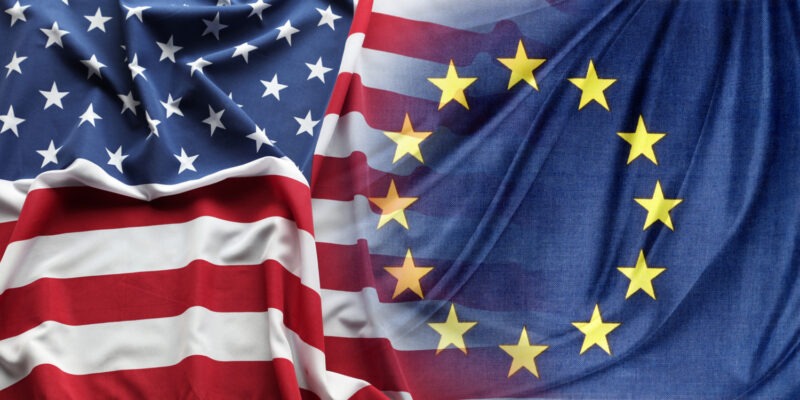US-EU Strike Trade Deal: The Impact on Pharma
The US and the EU came to terms on new trade deal, which includes a single, all-inclusive US tariff ceiling of 15% for EU goods. How do pharmaceuticals factor into the new deal?
By Patricia Van Arnum, Editorial Director, DCAT, pvanarnum@dcat.org
New EU-US trade deal
Earlier this week (July 27, 2025), European Commission President Ursula von der Leyen and US President Donald J. Trump agreed to a deal on tariffs and trade. The deal ends a back-and-forth trade negotiations between the US and the European Union (EU), which was facing a potential 30% tariff as of August 1, 2025.
The key commitments of both sides overall and those impacting pharmaceuticals by the European Commission are outlined below.
US tariff ceiling of 15%. The deal establishes a single, all-inclusive US tariff ceiling of 15% for EU goods. As of August 1, 2025, the US will apply this maximum tariff on the vast majority of EU exports. It is an all-inclusive tariff rate and represents a ceiling, including the US most-favored-nation (MFN) tariff that was previously stacked on top of additional tariffs the US introduced, according to the European Commission.
Pharmaceuticals. The European Commission specifies that the 15% tariff ceiling will also apply to any potential future tariffs on pharmaceuticals and semiconductors, including those based on Section 232 of the Trade Expansion Act of 1962 in the US, as amended, which allows the President to impose import restrictions based on an investigation and affirmative determination by the US Department of Commerce that certain imports threaten to impair US national security. The US had initiated a Section 232 investigation earlier this year (April 2025) for pharmaceuticals. Depending on the findings of that investigation, the President can decide whether to impose tariffs or quotas to offset the adverse effect on national security, without limits on the duration of the tariffs and can apply them to specific products or countries. The European Commissions says that until the US decides whether to impose additional tariffs on these products pursuant to Section 232, EU goods will remain subject only to US MFN tariffs—that is a point of needed clarity between the two sides.
Providing special treatment for strategic products. As of August 1, 2025, US tariffs on certain EU chemicals, generic drugs, natural resources, and aircraft and aircraft parts, will go back to pre-January (January 2025) levels. This will provide immediate tariff relief for key EU industries while the EU and US agreed to keep working to add more products to this list.
Reciprocal tariffs. The 15% ceiling applies to nearly all EU exports currently subject to reciprocal tariffs, referring to country-by-country imposed tariffs (except where the US MFN tariff exceeds 15%, in which case only the MFN tariff applies with no additional tariffs on top). The Trump Administration first laid out a plan for imposing reciprocal tariffs in February (February 2025) to counter non-reciprocal trading arrangements with its trading partners and to improve US competitiveness, including in manufacturing. Those reciprocal taxes were scheduled to go into effect on April 9, 2025, but the Administration placed a 90-day pause (until July 9, 2025) on their implementation to enable countries to negotiate these tariffs with the US government. The US government then extended the deadline once again to August 1, 2025, except for 14 countries, which were sent letters from the White House to specify tariffs ranging from 25% to 40%.
Strengthening cooperation on economic security. The EU and US will enhance supply chain resilience and address non-market policies and practices. They will also continue to cooperate on investment screening and export controls.
Ensuring reliable access to critical energy and future-oriented supplies. The EU intends to procure US liquified natural gas, oil, and nuclear energy products with an expected offtake valued at $750 billion over the next three years (as reported on July 28, 2025). This will contribute to replacing Russian gas and oil on the EU market. The EU also intends to purchase EUR 40 billion ($46 billion) worth of AI chips essential to maintaining the EU’s technological edge.
Promoting and facilitating mutual investments on both sides. EU companies have expressed interest in investing at least $600 billion in various sectors in the US by 2029, further boosting the already significant EUR 2.4 trillion ($2.7 trillion) in existing investment.
EU chemicals and pharma industries weigh in
Both the European pharma and chemical industries raised their concerns on the imposition of tariffs and a lack of clarity in defining those tariffs. The European Federation of Pharmaceutical Industries and Associations (EFPIA), which represents innovator-drug companies and national pharmaceutical associations in Europe, raised concerns over the deal for a lack of clarity on how the deal impacts pharmaceuticals and a broader criticism on tariffs.
“EFPIA continues to review announcements on the EU–US trade deal as key implications for the pharmaceutical sector remain uncertain,” said EFPIA in a July 28, 2025, statement. “Tariffs on medicines are a blunt instrument that will disrupt supply chains, impact on investment in research and development, and ultimately harm patient access to medicines on both sides of the Atlantic.”
EFPIA is calling on EU authorities to re-think how they value innovation and asserting that tariffs are not an effective mechanism to rebalance trade between the US and EU. “If the intent is to secure pharmaceutical investment in research, development and manufacturing, rebalance trade and ensure a fairer distribution of how global pharmaceutical innovation is financed, then there are more effective means than tariffs that would help, rather than hinder, global advances in patient care and economic growth,” said EFPIA in its statement. “From a European perspective, it means rethinking how we value innovation, significantly increasing what the region spends on innovative medicines and creating an operating environment that can accelerate turning Europe’s great science into new treatments.”
The European Chemical Industry Council (Cefic), which represents chemical manufacturers in Europe, also noted the uncertainty that the EU–US trade deal poses for the European chemical industry. “We take note of the newly announced EU-US deal on tariffs and trade and call for further details as soon as possible,” said Cefic in a July 28, 2025, statement. “While the deal appears to have averted the worst-case scenario, the additional US tariffs on European exports risk further eroding the competitiveness of the EU chemical industry. This is another reminder that the recently published Chemical Industry Action Plan needs to be urgently and fully implemented. There is no time to waste.”
The Chemical Industry Action Plan, which was announced last month (July 2025) seeks to strengthen the competitiveness and modernization of the EU chemicals sector by addressing key challenges of high energy costs, global competition, and weak demand while promoting investment in innovation and sustainability (see related story, “Taking the Pulse: The EU’s Action Plan for Revitalizing the Chemicals Industry”).
Cefic points out the additional tariffs hinder trade and investment flows across the Atlantic, which is probematic for an integrated transatlantic chemical industry with a significant amount of intra-industry and intra-company trade, pointing specifically to raw and input materials.
One encouraging sign notes Cefic is the proposed inclusion of certain chemicals in the “zero-for-zero tariff” agreement, which occurs when participating countries eliminate tariffs on specific goods or sectors.







